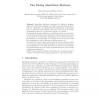Free Online Productivity Tools
i2Speak
i2Symbol
i2OCR
iTex2Img
iWeb2Print
iWeb2Shot
i2Type
iPdf2Split
iPdf2Merge
i2Bopomofo
i2Arabic
i2Style
i2Image
i2PDF
iLatex2Rtf
Sci2ools
51
Voted
EUROPAR
2007
Springer
2007
Springer
Fine Tuning Algorithmic Skeletons
Abstract. Algorithmic skeletons correspond to a high-level programming model that takes advantage of nestable programming patterns to hide the complexity of parallel/distributed applications. Programmers have to: define the nested skeleton structure, and provide the muscle (sequential) portions of code which are specific to a problem. An inadequate structure definition, or inefficient muscle code can lead to performance degradation of the application. Related research has focused on the problem of performing optimization to the skeleton structure. Nevertheless, to our knowledge, no focus has been done on how to aide the programmer to write performance efficient muscle code. We present the Calcium skeleton framework as the environment in which to perform fine tuning of algorithmic skeletons. Calcium provides structured parallelism in Java using ProActive. ProAcitve is a grid middleware implementing the active object programming model, and providing a deployment framework. Finally, u...
| Added | 07 Jun 2010 |
| Updated | 07 Jun 2010 |
| Type | Conference |
| Year | 2007 |
| Where | EUROPAR |
| Authors | Denis Caromel, Mario Leyton |
Comments (0)

